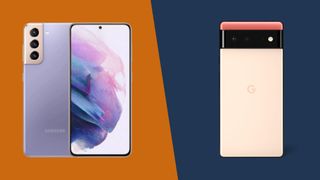
The Google Pixel 6 is here, and it’s instantly jumped to the top (or near enough) of the desirable upper-mid-range smartphone charts.
It’s going to have to contend with a seasoned veteran of the format if it’s to succeed, though. The Samsung Galaxy S21 might be getting on a bit now, but it’s still one of the best phones of its kind.
So which of these two competitively priced almost-flagships is the better buy? We’ve put both phones to the test, and found that both have their unique strengths and weaknesses.
Google Pixel 6 vs Samsung Galaxy S21 price and availability
Google Pixel 6 deals will be available from October 28, with prices starting from $599 / £599 / AU$999 for 128GB. There's also a 256GB model that will set you back AU$1,129, with pricing in other regions still to be confirmed at the time of writing.
The Samsung Galaxy S21 landed on January 29, 2021, with prices starting from $799 / £769 / AU$1,249 for the 128GB model. The 256GB model arrived at $849.99 / £819 / AU$1,349.
These prices still apply on the official Samsung website, despite the age of the handset. However, you'll almost certainly be able to find a better deal on this phone if you shop around the usual third-party suspects.
Even so, the Pixel 6 is clearly the more affordable phone of the two out of the gate. Round one to Google, it seems.
Get daily insight, inspiration and deals in your inbox
Get the hottest deals available in your inbox plus news, reviews, opinion, analysis and more from the TechRadar team.
Design
The Google Pixel 6 isn't a small phone by any means. Its footprint of 158.6 x 74.8mm isn't especially large, but it's quite a thick handset at 8.9mm, and it weighs a not inconsiderable 207g.
Contrast that with the Samsung Galaxy S21, which measures a mere 151.7 x 71.2 x 7.9mm, and weighs a piddling 169g.
One reason the Samsung is so lightweight is the adoption of a new 'Glasstic' material for the rear cover, which is basically a slightly classier-feeling plastic. Google has gone with a more premium glass and metal sandwich approach.
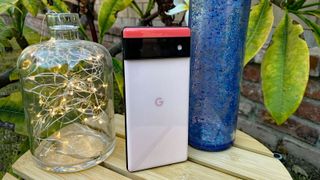
We loved the Galaxy S21’s swooping camera module design, but Google has gone with its own distinctive lens array with the Pixel 6. Its two-tone rear panel and width-spanning ‘visor’ module don’t quite look like any other phone on the market.
That visor means that the phone doesn’t rock when you lay it down on a flat surface, which is a rarity. We do have concerns about its likely vulnerability, though. The camera feels awfully exposed, and we felt compelled to keep the phone in a case during our test phase.
On the color front, Samsung offers Phantom Gray, Phantom White, Phantom Pink, and Phantom Violet. Google goes with Stormy Black, Sorta Seafoam, and Kinda Coral. These are two of the brightest selections out there.
Both phones give you an IP68 dust and water resistance rating, as well as Gorilla Glass Victus protecting their flat displays. Both phones position their punch-hole cameras to the center of the display, too, which lends a certain sense of symmetry to things.
Display
Both of these phones have relatively compact displays, at least by the standards of modern Android flagships.
The Google Pixel 6 gives you a 6.4-inch OLED while the Samsung Galaxy S21 goes with a 6.2-inch OLED. Both have 1080 x 2400 (FHD+) resolutions.
Still, that makes the Pixel 6 display the second-largest Pixel screen ever, after the Pixel 6 Pro. Google also seems to have imbued the Pixel 6 with some Samsung-like vibrant colors, and we were impressed by its contrast.
Samsung wins on the smoothness front, however. It gets a 120Hz refresh rate compared to the Pixel 6's 90Hz. We're a little disappointed with the latter, in truth. Similarly priced and positioned phones like the OnePlus 9 give you the full 120Hz treatment, after all.
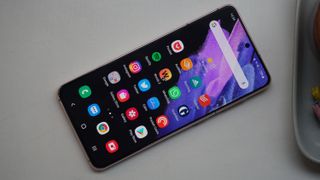
Another way in which the Galaxy S21’s display is more advanced than the Pixel 6’s is through its use of LTPO technology, which lets it scale back to 48Hz when the situation dictates. You’d have to upgrade to the Google Pixel 6 Pro to get a similar feature on the Google side of things.
Meanwhile, The Google Pixel 6 can’t match the Samsung Galaxy S21’s peak brightness of around 1300 nits.
Overall, it’s nip and tuck between these two smartphone displays, but we’d probably give the edge to the Samsung.
Camera
Google and Samsung have always handled cameras a little differently. Google has been all about the software and algorithmic mastery, while Samsung tends to go all in with the hardware.
The Pixel 6 shows signs of change. After several years of stagnation, Google has finally upped its hardware game with a new 1/1.31-inch 50MP wide camera that produces 1.2μm pixels. This is accompanied by an f/1.85 aperture.
Samsung's phone is led by a 1/1.76-inch 12MP f/1.8 wide sensor that produces larger 1.8μm pixels, though it's worth pointing out that Google's system will use pixel binning to combine the information of multiple pixels into one.
Both phones go with 12MP ultra-wides with f/2.2 apertures. But while the Pixel 6 lacks a dedicated telephoto sensor, the Galaxy S21 gives you a meaty 64MP sensor with a 3x hybrid optical zoom. Advantage Samsung.

Neither phone lacks software tricks. With the Pixel 6, Face Unblur cleans up blurry human subjects, while Magic Eraser smartly removes unwanted background elements for those perfectly composed shots.
The Galaxy S21 is all about the video, with Director's View presenting a live view of all three rear lenses at once and enabling you to hop between them, while Vlogger View enables you to record video from the front and rear cameras simultaneously.
Talking of video, the Samsung Galaxy S21 can manage 8K at 24fps or 4K at 60fps, while the Google Pixel 6 can hit 4K at 60fps.
Not that the Pixel 6 is lacking on the video front, with Live HDR+ using the Tensor chipset to enhance colors and tones, and Speech Enhancement pulling out voices amongst the background noise.
On the front, you get a 10MP f/2.2 camera on the Samsung Galaxy S21, and an 8MP f/2.0 one on the Pixel 6. All in all, the Pixel 6 takes better stills in general shooting, but the Galaxy S21 camera is the more flexible of the two.
Specs and performance
Both of these phones run on custom silicon, and neither sets the benchmark tests alight.
Google’s new Tensor chip scored an average Geekbench 5 multi-core score of 2837 in our tests. That’s comfortably beaten by the global Galaxy S21 model’s Exynos 2100 chip, which scored 3367 - That in turn is comfortably beaten by more or less every Snapdragon 888 flagship phone on the market, including the US Galaxy S21.
Not that these benchmark tests have much of a bearing on general usage, which is rapid on both phones. Just like Samsung’s phone, the Pixel 6 breezes through browsing, watching media, and other tasks.
Both of these phones run 8GB of LPDDR5 RAM, and both offer the choice of either 128GB or 256GB of internal storage.
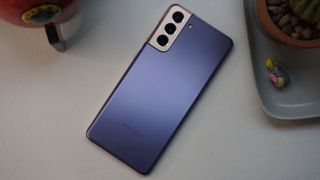
For all these various hardware considerations, perhaps the biggest differentiating factor between the Pixel 6 and Samsung Galaxy S21 relates to software.
The Pixel 6 runs Android 12 out of the box, and it’s as pure a take on Google’s operating system as you can get. This time around that includes the new Material You UI - a bold, widget-heavy interface that features a smart theming system.
In the other corner, Samsung supplies its own custom One UI currently based on Android 11. It’s not everyone’s favorite Android skin, but it is fluid and highly customizable.
It’s unlikely that Samsung is ever going to match Google’s promise of a minimum of three full Android versions, though.
Battery
The Google Pixel 6 packs a 4,612mAh battery, which is a fair bit larger than the Samsung Galaxy S21’s 4,000mAh cell. True, the Pixel 6’s display is a little larger. But Samsung’s screen runs at a higher refresh rate.
Google is promising an ambitious 48-hour battery life, though that’s when using its Extreme Battery Saver mode. In normal usage, it’s targeting all-day life.
In our review we found that both phones could last through a full day of usage on a single charge. More intensive tasks, such as those that make use of GPS, might eat into that, but generally there’s nothing to worry about here.
Google has a clear edge when it comes to recharging. The Pixel 6 supports 30W wired charging and 21W wireless charging. The Samsung Galaxy S21, by comparison, supports 25W wired and 15W wireless. You’ll have to buy any chargers separately in both cases, however.
The likes of Xiaomi and OnePlus offer 65W (and beyond) chargers in the box, so we’re pretty unimpressed with Google and Samsung on this one.
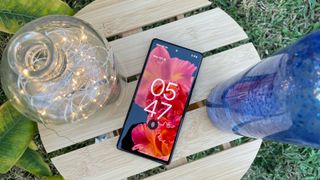
Takeaway
Google has brought an exciting new contender to one of the most vibrant areas of the market with the Pixel 6. It undercuts the Samsung Galaxy S21 on price while offering broadly competitive specs.
Samsung’s phone still has the edge in terms of camera versatility and display fluidity, but the Pixel 6 is no slacker in either department. Indeed, it might just have the edge in terms of image quality from its main wide sensor.
Right now, the Pixel 6’s exciting new design and bold Material You UI makes it the most exciting phone on the market, together with its Pro brother.
That freshness, together with the level of Google’s promised ongoing support, might just give Google’s phone the edge over Samsung’s long-in-the-tooth flagship. But this is a close-run thing alright.
- Read our Google Pixel 6 Pro review
You might also want to check out the Samsung Galaxy S21 vs Samsung Galaxy S20 comparison.
Most Popular

